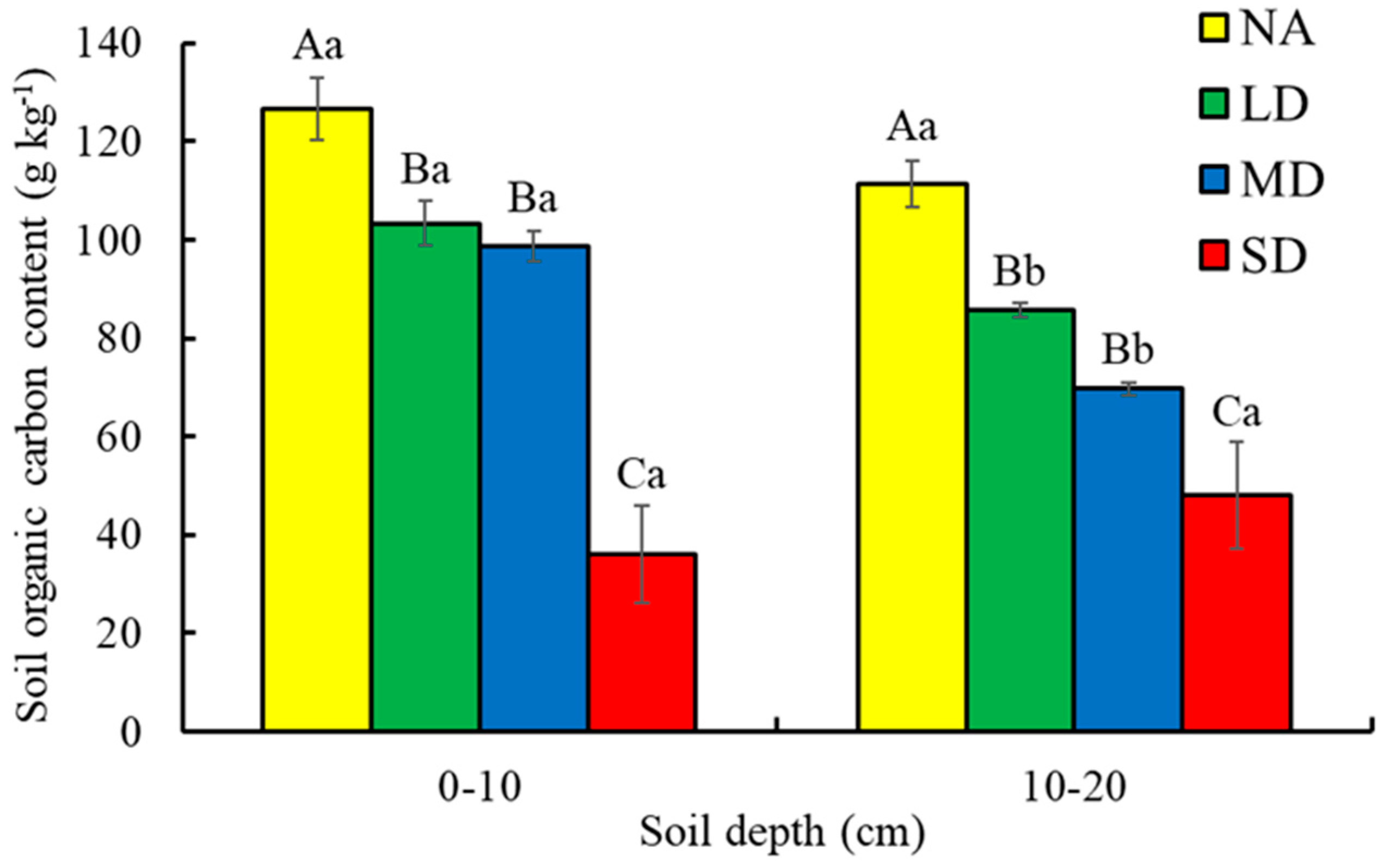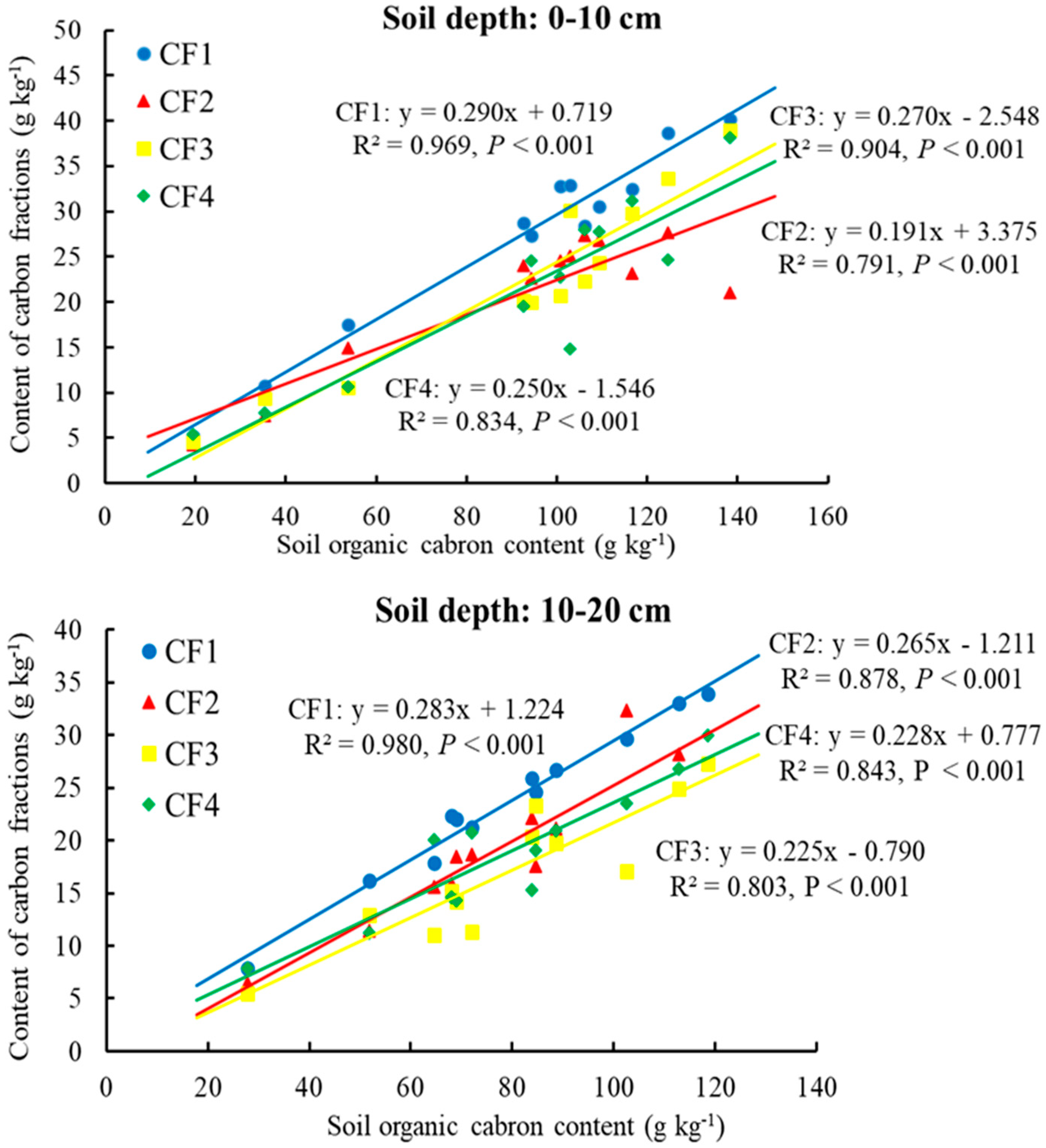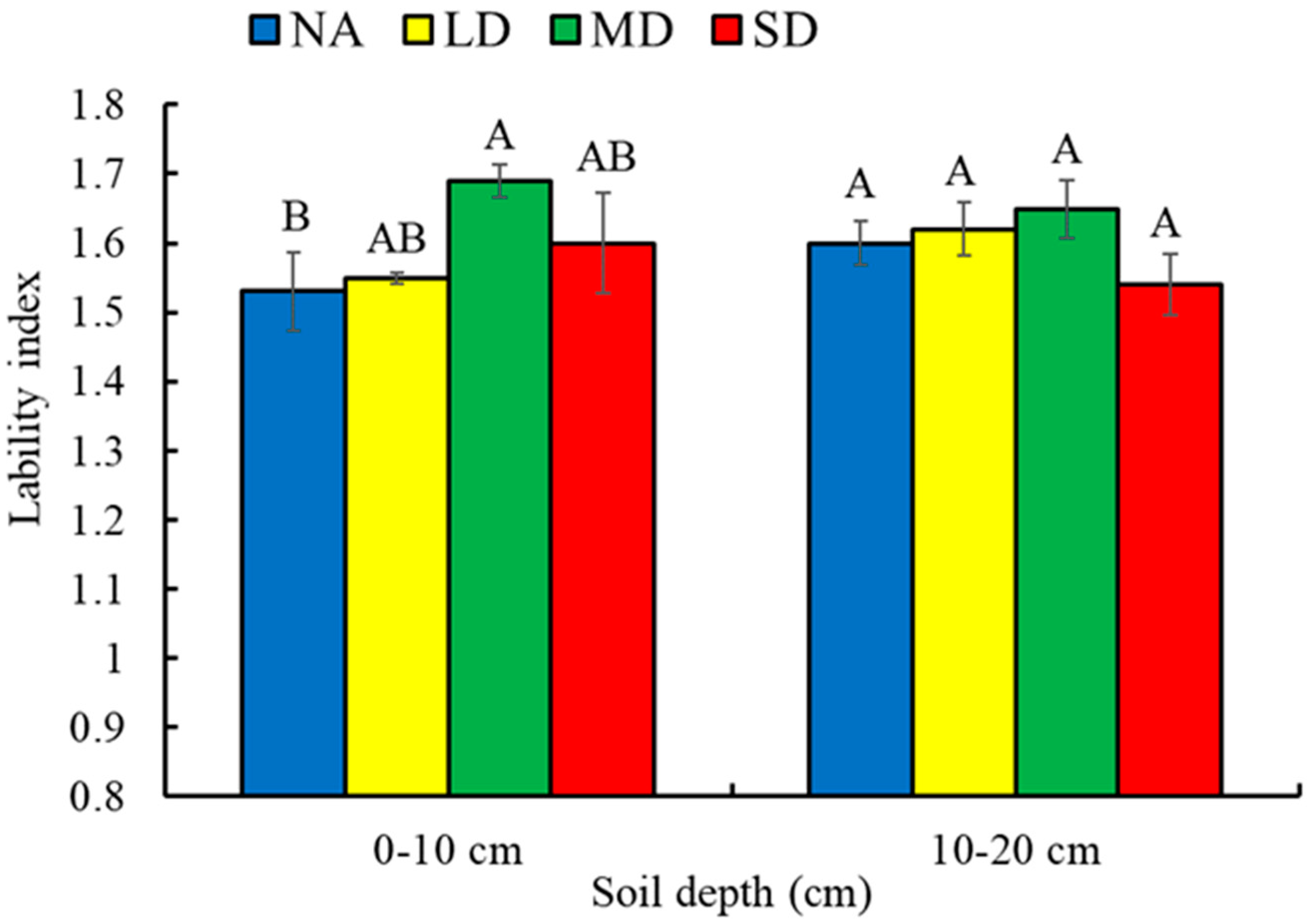Dynamics of Soil Carbon Fractions and Carbon Stability in Relation to Grassland Degradation in Xinjiang, Northwest China
Abstract
:1. Introduction
2. Materials and Methods
2.1. Study Area
2.2. Sampling Design
2.3. Soil Analysis
- (1)
- Very labile carbon fraction (CF1): Carbon oxidized by 6 N H2SO4.
- (2)
- Labile carbon fraction (CF2): Carbon oxidized by 12 N H2SO4—Carbon fraction oxidized by 6 N H2SO4.
- (3)
- Less labile carbon fraction (CF3): Carbon oxidized by 18 N H2SO4—Carbon oxidized by 12 N H2SO4.
- (4)
- Non-labile carbon fraction (CF4): Total SOC content—Carbon oxidized by 18 N H2SO4.
2.4. Calculation of Soil Organic Carbon Stability
2.5. Statistical Analyses
3. Results
3.1. Contents of Soil Organic Carbon
3.2. Content of Soil Organic Carbon Fractions
3.3. Relationships of Total Soil Organic Carbon and Its Fractions
3.4. The Lability Index of Soil Organic Carbon
4. Discussion
5. Conclusions
Author Contributions
Funding
Institutional Review Board Statement
Informed Consent Statement
Data Availability Statement
Acknowledgments
Conflicts of Interest
References
- Shen, X.; Yang, F.; Xiao, C.W.; Zhou, Y. Increased contribution of root exudates to soil carbon input during grassland degradation. Soil Biol. Biochem. 2020, 146, 107817. [Google Scholar] [CrossRef]
- Liu, X.; Chen, D.T.; Yang, T.; Huang, F.R.; Fu, S.; Li, L.H. Changes in soil labile and recalcitrant carbon pools after land-use change in a semi-arid agro-pastoral ecotone in Central Asia. Ecol. Indic. 2020, 110, 105925. [Google Scholar] [CrossRef]
- Köchy, M.; Hiederer, R.; Freibauer, A. Global distribution of soil organic carbon—Part 1: Masses and frequency distributions of SOC stocks for the tropics, permafrost regions, wetlands, and the world. Soil 2015, 1, 351–365. [Google Scholar] [CrossRef] [Green Version]
- Bongiorno, G.; Bunemann, E.K.; Oguejiofor, C.U.; Meier, J.; Gort, G.; Comans, R.; Mader, P.; Brussaard, L.; Goede, R. Sensitivity of labile carbon fractions to tillage and organic matter management and their potential as comprehensive soil quality indicators across pedoclimatic conditions in Europe. Ecol. Indic. 2019, 99, 38–50. [Google Scholar] [CrossRef]
- Benbi, D.K.; Brar, K.; Toor, A.S.; Singh, P. Total and labile pools of soil organic carbon in cultivated and undisturbed soils in northern India. Geoderma 2015, 237, 149–158. [Google Scholar] [CrossRef]
- Duan, Y.; Chen, L.; Li, Y.M.; Wang, Q.Y.; Zhang, C.Z.; Ma, D.H.; Li, J.Y.; Zhang, J.B. N, P and straw return influence the accrual of organic carbon fractions and microbial traits in a Mollisol. Geoderma 2021, 403, 115373. [Google Scholar] [CrossRef]
- Stockmann, U.; Adams, M.A.; Crawford, J.W.; Field, D.J.; Henakaarchchi, N.; Jenkins, M.; Minasny, B.; McBratney, A.B.; de Remy de Courcells, V.; Singh, K.; et al. The knowns, known unknowns and unknowns of sequestration of soil organic carbon. Agric. Ecosyst. Environ. 2013, 164, 80–99. [Google Scholar] [CrossRef]
- Rahmati, M.; Eskandari, I.; Kouselou, M.; Feiziasl, V.; Mahdavinia, G.R.; Aliasgharzad, N.; McKenzie, B.M. Changes in soil organic carbon fractions and residence time five years after implementing conventional and conservation tillage practices. Soil Tillage Res. 2020, 200, 104632. [Google Scholar] [CrossRef]
- Conant, R.T.; Cerri, C.E.P.; Osborne, B.B.; Paustian, K. Grassland management impacts on soil carbon stocks: A new synthesis. Ecol. Appl. 2017, 27, 662–668. [Google Scholar] [CrossRef] [PubMed] [Green Version]
- Yu, P.J.; Li, Y.X.; Liu, S.W.; Ding, Z.; Zhang, A.C.; Tang, X.G. The quantity and stability of soil organic carbon following vegetation degradation in a salt-affected region of Northeastern China. Catena 2022, 211, 105984. [Google Scholar] [CrossRef]
- Wang, H.B.; Jin, J.; Yu, P.Y.; Fu, W.J.; Morrison, L.; Lin, H.P.; Meng, M.L.J.; Zhou, X.F.; Lv, Y.L.; Wu, J.S. Converting evergreen broad-leaved forests into tea and Moso bamboo plantations affects labile carbon pools and the chemical composition of soil organic carbon. Sci. Total Environ. 2020, 711, 135225. [Google Scholar] [CrossRef] [PubMed]
- Wick, A.F.; Geaumont, B.A.; Sedivec, K.; Hendrickson, J. Grassland degradation. Biol. Environ. Hazards Risks Disasters 2016, 8, 257–276. [Google Scholar]
- Henneron, L.; Cros, C.; Picon-Cochard, C.; Rahimian, V.; Fontaine, S. Plant economic strategies of grassland species control soil carbon dynamics through rhizodeposition. J. Ecol. 2020, 108, 528–545. [Google Scholar] [CrossRef]
- Lorenz, K.; Lal, R.; Ehlers, K. Soil organic carbon stock as an indicator for monitoring land and soil degradation in relation to Unite Nations’ Sustainable Development Goals. Land Degrad. Dev. 2019, 30, 824–838. [Google Scholar] [CrossRef]
- Peng, F.; Xue, X.; You, Q.G.; Sun, J.; Zhou, J.; Wang, T.; Tsunekawa, A. Change in the tradeoff between above- and belowground biomass of alpine grassland: Implications for the land degradation process. Land Degrad. Dev. 2020, 31, 105–117. [Google Scholar] [CrossRef]
- McSherry, M.E.; Ritchie, M.K. Effects of grazing on grassland soil carbon: A global review. Glob. Chang. Biol. 2013, 19, 1347–1357. [Google Scholar] [CrossRef]
- Yang, Y.; Tilman, D.; Furey, G.; Lehman, C. Soil carbon sequestration accelerated by restoration of grassland biodiversity. Nat. Commun. 2019, 10, 718. [Google Scholar] [CrossRef] [Green Version]
- Wang, Y.; Ren, Z.; Ma, P.P.; Wang, Z.M.; Niu, D.C.; Fu, H.; Elser, J.J. Effects of grassland degradation on ecological stoichiometry of soil ecosystems on the Qinghai-Tibet Plateau. Sci. Total Environ. 2020, 722, 137910. [Google Scholar] [CrossRef]
- Paul, E.A. The nature and dynamics of soil organic matter: Plant inputs, microbial transformations, and organic matter stabilization. Soil Biol. Biochem. 2016, 98, 109–126. [Google Scholar] [CrossRef] [Green Version]
- Kopecky, M.; Peterka, J.; Kolar, L.; Konvalina, P.; Marousek, J.; Vachalova, R.; Herout, M.; Strunecky, O.; Batt, J.; Tran, D.K. Influence of selected maize cultivation technologies on changes in the labile fraction of soil organic atter sandy-loam cambisol soil structure. Soil Tillage Res. 2021, 207, 104865. [Google Scholar] [CrossRef]
- You, X.N.; Li, X.Y.; Sillanpaa, M.; Wang, R.; Wu, C.Y.; Xu, Q.Q. Export of dissolved organic carbon from the source region of Yangtze river in the Tibetan Plateau. Sustainanility 2022, 14, 2441. [Google Scholar] [CrossRef]
- Ladoni, M.; Basir, A.; Kravchenko, A. Which soil carbon fraction is the best for assessing management differences? A statistical power perspective. Soil Sci. Soc. Am. J. 2015, 79, 848–857. [Google Scholar] [CrossRef]
- Li, T.T.; Zhang, Y.L.; Bei, S.K.; Li, X.L.; Reinsch, S.; Zhang, H.Y.; Zhang, J.L. Contrasting impacts of manure and inorganic fertilizer applications for nine years on soil organic carbon and its labile fractions in bulk soil and soil aggergates. Catena 2020, 194, 104739. [Google Scholar] [CrossRef]
- Ding, X.L.; Han, X.Z.; Liang, Y.; Qiao, Y.F.; Li, L.J.; Li, N. Changes in soil organic carbon pools after 10 years of continuous manuring combined with chemical fertilizer in a Mollisol in China. Soil Tillage Res. 2012, 122, 36–41. [Google Scholar] [CrossRef]
- Yu, P.J.; Li, Y.X.; Liu, S.W.; Liu, J.L.; Ding, Z.; Ma, M.G.; Tang, X.G. Afforestation influences soil organic carbon and its fractions associated with aggregates in a karst region of Southwest China. Sci. Total Environ. 2022, 814, 152710. [Google Scholar] [CrossRef]
- Garcia-Diaz, A.; Marques, M.J.; Sastre, B.; Bienes, R. Labile and stable soil organic carbon and physical improvements using groundcovers in vineyards from central Spain. Sci. Total Environ. 2018, 621, 387–397. [Google Scholar] [CrossRef] [Green Version]
- Nandan, R.; Singh, V.; Singh, S.S.; Kumar, V.; Hazra, K.K.; Nath, C.P.; Poonia, S.; Malik, R.K.; Bhattacharyya, R.; McDonald, A. Impact of conservation tillage in rice-based cropping systems on soil aggregation, carbon pools and nutrients. Geoderma 2019, 340, 104–114. [Google Scholar] [CrossRef]
- Chan, K.Y.; Bowman, A.; Oates, A. Oxidizible organic carbon fractions and soil quality changes in oxicpaleustalf under different pasture leys. Soil Sci. 2001, 166, 61–67. [Google Scholar] [CrossRef]
- Yu, P.J.; Liu, S.W.; Zhang, L.; Li, Q.; Zhou, D.W. Selecting the minimum data set and quantitative soil quality indexing of alkaline soils under different land uses in northeastern China. Sci. Total Environ. 2018, 616, 564–571. [Google Scholar] [CrossRef]
- Mchunu, C.; Chaplot, V. Land degradation impact on soil carbon losses through water erosion and CO2 emissions. Geoderma 2012, 177, 72–79. [Google Scholar] [CrossRef]
- Zhang, G.G.; Kang, Y.M.; Han, G.D.; Mei, H.; Sakurai, H. Grassland degradation reduces the carbon sequestration capacity of the vegetation and enhances the soil carbon and nitrogen loss. Acta Agric. Scand. Sect. B Soil Plant Sci. 2011, 61, 356–364. [Google Scholar] [CrossRef]
- Liu, S.B.; Zamanian, K.; Schleuss, P.M.; Zarebanadkouki, M.; Kuzyakov, Y. Degradation of Tibetan grasslands: Consequences for carbon and nutrient cycles. Agric. Ecosyst. Environ. 2018, 252, 93–104. [Google Scholar] [CrossRef]
- Yu, P.J.; Liu, S.W.; Ding, Z.; Zhang, A.C.; Tang, X.G. Changes in storage and the stratification ratio of organic carbon under different vegetation types in the Northeastern China. Agronomy 2020, 10, 290. [Google Scholar] [CrossRef] [Green Version]
- Rakesh, S.; Sarkar, D.; Sinha, A.K.; Danish, S.; Bhattacharya, P.M.; Mukhopaduyay, P.; Salmen, S.H.; Ansari, M.J.; Datta, R. Soil organic carbon and labile and recalcitrant carbon fractions attributed by contrasting tillage and cropping systems in old and recent alluvial soils of subtropical eastern India. PLoS ONE 2021, 16, e0259645. [Google Scholar]
- Luo, Z.K.; Rossel, R.A.V.; Shi, Z. Distinct controls over the temporal dynamics of soil carbon fractions after land use change. Glob. Chang. Biol. 2020, 26, 4614–4625. [Google Scholar] [CrossRef]
- Singh, J.; Kumar, S. Seasonal changes of soil carbon fractions and enzyme activities in response to winter cover crops under long-tern rotation and tillage systems. Eur. J. Soil Sci. 2021, 72, 886–899. [Google Scholar] [CrossRef]
- Rennert, T.; Ghong, N.P.; Rinklebe, J. Permanganate-oxidizable soil organic matter in floodplain soils. Catena 2017, 149, 381–384. [Google Scholar] [CrossRef]
- Yang, J.J.; Li, A.Y.; Yang, Y.F.; Li, G.H.; Zhang, F. Soil organic carbon stability under natural and anthropogenic-induced perturbations. Earth-Sci. Rev. 2020, 205, 103199. [Google Scholar] [CrossRef]
- Liu, H.; Zhang, J.; Ai, Z.; Wu, Y.; Xu, H.; Li, Q.; Xue, S.; Liu, G. 16-Year fertilization changes the dynamics of soil oxidizable organic carbon fractions and the stability of soil organic carbon in soybean-corn agroecosystem. Agric. Ecosyst. Environ. 2018, 265, 320–330. [Google Scholar] [CrossRef]




| Soil Organic Carbon | Very Labile Carbon | Labile Carbon | Less Labile Carbon | Non-Labile Carbon | |||||||
|---|---|---|---|---|---|---|---|---|---|---|---|
| df | F | P | F | P | F | P | F | P | F | P | |
| Grassland degradation (GD) | 3 | 52.82 | <0.001 | 41.62 | <0.001 | 28.73 | <0.001 | 26.81 | <0.001 | 20.54 | <0.001 |
| Soil depth (SD) | 1 | 8.04 | 0.012 | 6.64 | 0.020 | 0.73 | 0.406 | 10.61 | 0.005 | 2.19 | 0.158 |
| GD*SD | 3 | 3.89 | 0.029 | 3.26 | 0.049 | 4.87 | 0.013 | 4.11 | 0.024 | 2.69 | 0.081 |
| Land Degradation | Native Grassland (NA) | Light Degradation (LD) | Moderate Degradation (MD) | Severe Degradation (SD) |
|---|---|---|---|---|
| Soil Depths (cm) | ||||
| CF1: Very labile carbon (g kg−1) | ||||
| 0–10 | 37.10 (±2.35) Aa | 28.77 (±0.93) Ba | 31.50 (±1.36) ABa | 11.17 (±3.55) Ca |
| 10–20 | 32.21 (±1.32) Aa | 25.72 (±0.60) Bb | 21.87 (±0.33) Bb | 14.02 (±3.09) Ca |
| CF2: Labile carbon (g kg−1) | ||||
| 0–10 | 23.94 (±1.95) Aa | 25.57 (±1.49) Aa | 24.58 (±0.29) Aa | 8.89 (±3.18) Ba |
| 10–20 | 29.27 (±1.56) Aa | 20.29 (±1.40) Ba | 17.68 (±0.90) Bb | 11.19 (±2.63) Ca |
| CF3: Less labile carbon (g kg−1) | ||||
| 0–10 | 34.18 (±2.66) Aa | 22.20 (±1.28) Ba | 23.64 (±3.23) Ba | 8.16 (±1.85) Ca |
| 10–20 | 23.11 (±3.09) Aa | 21.17 (±1.11) Aa | 13.57 (±1.16) Bb | 9.81 (±2.34) Ba |
| CF4: Non-labile carbon (g kg−1) | ||||
| 0–10 | 31.33 (±3.88) Aa | 26.76 (±1.12) ABa | 19.03 (±2.30) Ba | 7.94 (±1.53) Ca |
| 10–20 | 26.77 (±1.87) Aa | 18.46 (±1.65) Bb | 16.53 (±2.10) Ba | 13.08 (±3.63) Ba |
Publisher’s Note: MDPI stays neutral with regard to jurisdictional claims in published maps and institutional affiliations. |
© 2022 by the authors. Licensee MDPI, Basel, Switzerland. This article is an open access article distributed under the terms and conditions of the Creative Commons Attribution (CC BY) license (https://creativecommons.org/licenses/by/4.0/).
Share and Cite
Xu, Q.; Wei, Y.; Zhao, X.; Xu, H. Dynamics of Soil Carbon Fractions and Carbon Stability in Relation to Grassland Degradation in Xinjiang, Northwest China. Sustainability 2022, 14, 5860. https://doi.org/10.3390/su14105860
Xu Q, Wei Y, Zhao X, Xu H. Dynamics of Soil Carbon Fractions and Carbon Stability in Relation to Grassland Degradation in Xinjiang, Northwest China. Sustainability. 2022; 14(10):5860. https://doi.org/10.3390/su14105860
Chicago/Turabian StyleXu, Qiao, Yan Wei, Xinfeng Zhao, and Hailiang Xu. 2022. "Dynamics of Soil Carbon Fractions and Carbon Stability in Relation to Grassland Degradation in Xinjiang, Northwest China" Sustainability 14, no. 10: 5860. https://doi.org/10.3390/su14105860
APA StyleXu, Q., Wei, Y., Zhao, X., & Xu, H. (2022). Dynamics of Soil Carbon Fractions and Carbon Stability in Relation to Grassland Degradation in Xinjiang, Northwest China. Sustainability, 14(10), 5860. https://doi.org/10.3390/su14105860





